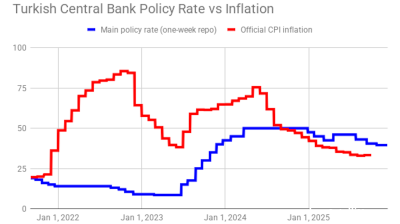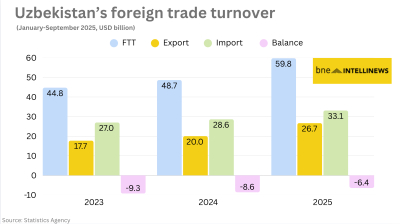The volume of new loans extended by Romanian banks in Q3 hit RON20bn (€4.38bn), a massive 14.8% increase on the year, according to bne IntelliNews calculations based on central bank data. The lending in the rolling four quarters hit RON73bn (€16bn), the highest level since 2010.
While retail mortgage lending rallied by 37% y/y, prompting concerns from central bank (particularly given the recent increase in the cost of money on the money market), corporate lending lost steam due to the lack of regulatory predictability in the fiscal area.
The credit expansion in Q3 was driven by lending to households (RON9.4bn), which expanded by 24.3% y/y. New mortgage loans ballooned by 37% y/y to RON3.7bn (€800mn) in the quarter. The volume of new consumer loans also increased by a double-digit rate (12.8% y/y) to RON5.2bn (€1.1bn).
The central bank issued a warning message in October, stressing that one third of the households that have contracted mortgage loans over the past year feature an indebtedness rate (the share of monthly instalments in total earnings) of over 55%. Nearly all the mortgage loans extended in the past years have been denominated in local currency. The increase in the money market interest rates will by default increase the value of instalments.
The National Committee for Macroprudential Surveillance (CNSM) estimates that an indebtedness rate of 55% indicates an average non-performing loan (NPL) rate of 3% within one year and 14% within five years (no standard deviation is provided for the average levels of the projected NPL rates). Currently, the NPL rate for the whole banking system has dropped below 10%.
Corporate lending increased as well, the volume of new loans contracted by companies having advanced by 7.5% y/y to RON7.3bn (€2.3bn). However, corporate lending has visibly lost momentum from stronger growth rates of 35% y/y in Q4 2016-Q1 2017 and 9.6% y/y in Q2. On average, the corporate lending increased by 9.6% y/y in 2016, meaning that in Q3 this year the advance actually decelerated.
The pattern might be explained by the lack of fiscal predictability generated by repeated fiscal amendments announced by the government. Consequently, the companies are expected to put major investments on hold until the fiscal policy gains clarity. In October, the government issued a new version of the amendments to the Fiscal Code with a significant impact on businesses. Its overall impact is not yet fully grasped by tax experts and furthermore the amendments have not yet been enacted (reportedly they will be by emergency ordinance during November).
Data

Turkey's central bank remains cautious, delivers 100bp rate cut
Decision comes on eve of next hearing in trial that could dislodge leadership of opposition CHP party.

Polish retail sales return to solid growth in September
Polish retail sales grew 6.4% year on year in constant prices in September, picking up from a 3.1% y/y rise in August, the statistics office GUS said.

Uzbekistan’s nine-month foreign trade nears $60bn
Export growth of 33% and import expansion of 16% y/y produce $6.4bn deficit.

Hungary’s central bank leaves rates unchanged
National Bank of Hungary expects inflation to fall back into the tolerance band by early 2026, with the 3% target sustainably achievable in early 2027 under the current strict policy settings.




